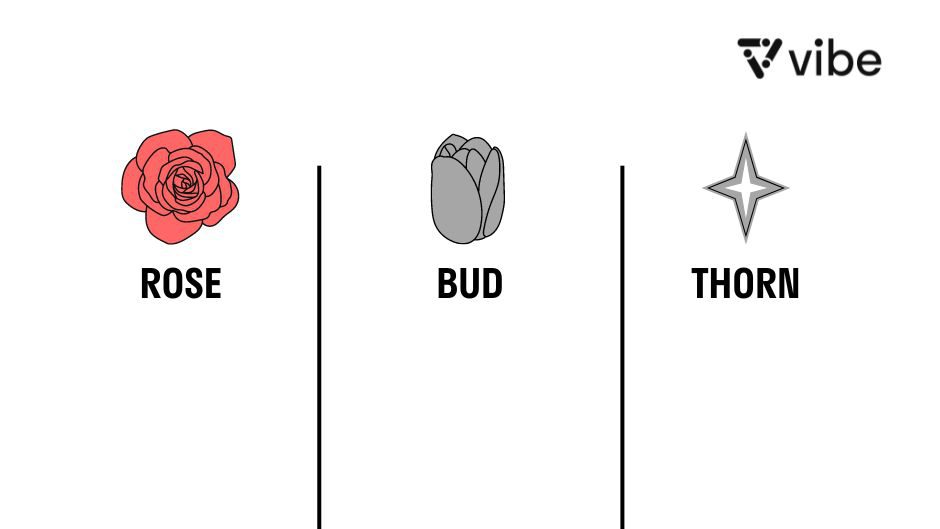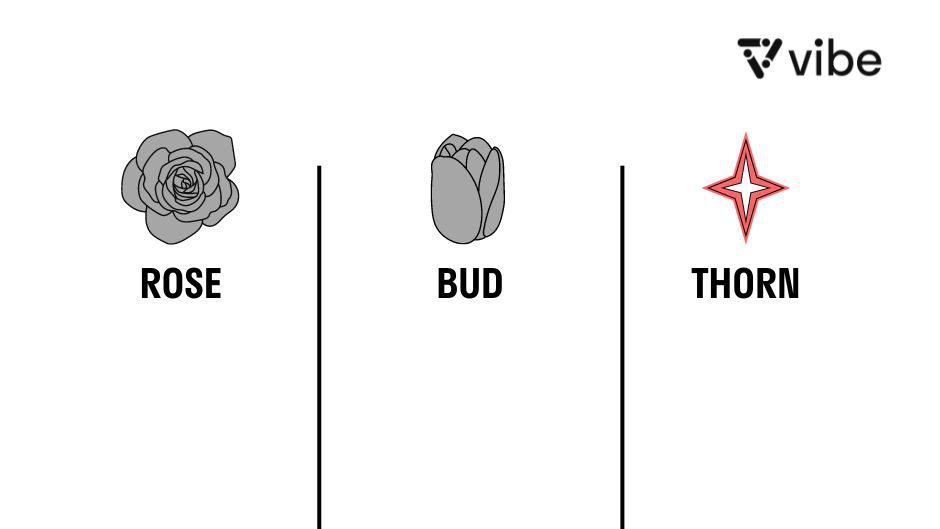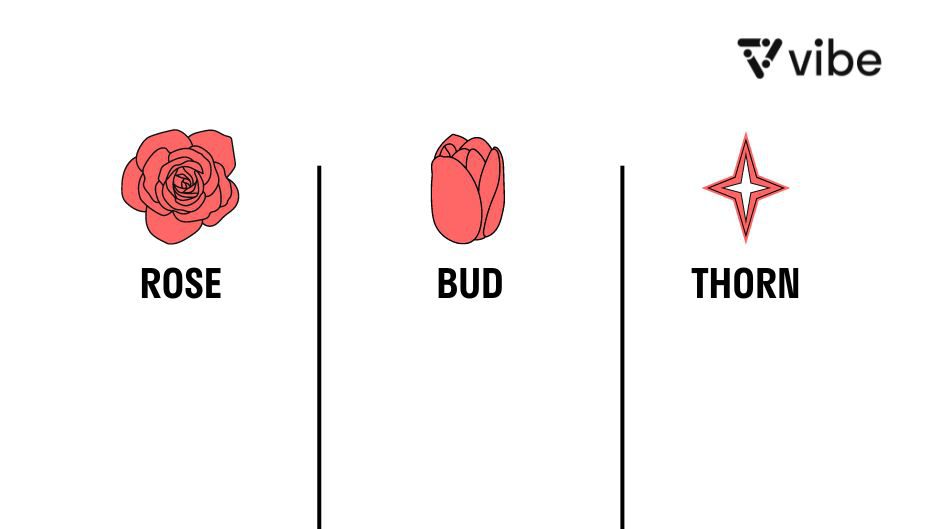In life, things are rarely straightforward. Our challenges often come in the form of a dilemma, forcing us to choose between two options that are almost equally unfavorable. As such, it’s no wonder that many people experience a crisis in finding a purpose in their life; they struggle to figure out what their unique contribution to the world should be. Fortunately, there are plenty of ways to get back on track and rediscover your sense of purpose again. The Rose, Bud, Thorn exercise is one such method for regaining control over your path and discovering new meaning in various things.
The Rose, Bud, Thorn exercise is not only used in the workplace, but also in classrooms, mindfulness courses, and one-on-one conversations with friends. The objective is to identify the "Rose, Bud, Thorn" in projects, events, or simply the day to analyze it.
What is the Rose, Bud, Thorn exercise?

The Rose, Bud, Thorn exercise is a creative approach to finding your unique purpose in various scenarios. This process of assessment is an excellent way to discover your passions and hone in on the activities that truly bring you joy. It can also be used for exploring your current situation, brainstorming to identify blind spots, and finding solutions to problems you’re experiencing.
The exercise can be used at any point in your life and is closely related to the WIP (What is important to you?) exercise. These two approaches can be used together to further discover what’s important to you and how you can best use your talents and skills for learning potential causes and do better.
How the Rose, Bud, Thorn Exercise Works

The Rose, Bud, Thorns activity is an excellent way to rediscover your path and find your purpose in life. This process is simple and straightforward, and anyone can do it regardless of background or education level.
To do the Rose, Bud, Thorn activity, you need to choose a word or a theme that’s important to you. The key is to select something meaningful to you.
Here, we’ll focus on its usefulness in the workplace, specifically in the context of problem-solving. In this situation, having various Roses, Buds, and Thorns will be more useful than selecting just one.
When you’re alone, you can choose whatever number you want. In a group setting, you may ask for one Rose, one Bud, and one Thorn from each member. To help stimulate your imagination, you can ask yourself some of the suggested questions in each section below, but feel free to come up with your own.
Once you’ve written the questions down, whether on a whiteboard or on notepads, take the time to speak over every point with your team.
Rose (Successes)

This section addresses the basic question, "What went well?"
These are the factors that drove the success of your group or project. How did you manage to achieve such great results in the past? The goal is to recognize and commend actions that led to favorable outcomes in the hopes that they’ll be performed in the future.
Bud (Opportunities)

In this section, teams are encouraged to consider the big picture.
As your team moves forward, it’s important to look for opportunities for improvement and anticipate your potential.
Thorn (Challenges)

The focus of this section is to identify obstacles that might derail the project.
The goal is to have a healthy discussion about any issues that are slowing down the team’s progress. Creating a welcoming environment in which these sensitive topics may be discussed is crucial to the success of this endeavor. Teams’ preparedness to foresee potential problems is a key factor in the project’s success.
Benefits of the Rose, Bud, Thorn Exercise

Below are some of the benefits you’ll get from the exercise:
-
Helps with categorization of research information
-
Gathers feedback and solicits ideas from all members of the team to better examine the issue and come up with a solution
-
Promotes meaningful exchanges of ideas; aids in spotting key problems and insights
-
Improves teamwork
-
Serves as an incentive to push oneself
-
Helps with problem-solving and makes the most of retrospective sessions
Rose, Bud, Thorn Examples

Here are a few examples of the Rose, Bud, Thorn exercise and how different professionals use this exercise to carry in their operations:
-
Individuals – Individuals can self-reflect using this exercise and consider the successes (roses), challenges (thorns) of the day while planning for the opportunities tomorrow presents (buds). These reflections can help individuals make the most out of each day, identify what isn’t working in their routine, and stay hopeful for the future.
-
UI/UX/Graphic Designer – This is a great activity to utilize when designing brochures, brand logos, website user interfaces, and smart product design that leaves a positive and memorable impression on customers. This activity guides designers toward a more accurate understanding of their target audience, which in turn informs their choice of design aspects like color palette, iconography, and text.
-
Consultants – Consultants can use this exercise to identify what’s working—and what isn’t—with their current clients. It can provide a framework for formulating questions to pose to their coworkers to get the project where it needs to be, or to better understand the needs of the client.
-
Marketing and Sales – This exercise helps teams determine which marketing strategies best convert prospects to customers. It also aids in strategy evaluation, development, and implementation.
-
Teachers and Students – This exercise can be a fantastic tool for classrooms. Teachers and students can reflect on certain lessons, assignments, and activities to see what’s working best for the class. Even better, you can work through this exercise on the classroom’s smart whiteboard, such as a Vibe Board. Vibe can help make learning accessible and let teachers understand their students’ needs.
Rose, Bud, Thorn Template

Having trouble finding the right words for your exercise? Try using this Retrospective Template to get the ball rolling with your Rose, Bud, Thorn exercise.
Structure your activities by documenting opinions or observations on sticky notes as negative, positive, or those with potential, and use different colors for every note to help you observe and consider the various patterns. You can also use a digital whiteboard to create your own Rose, Bud, Thorn Template.
Simply select a theme that’s important to you and follow the questions below to find your path again:
-
What’s important to you? This can be anything in your life that you truly care about. What do you love doing? What hobbies, passions, or interests bring you joy?
-
What are your strengths and gifts?
-
What are you good at?
-
What are your weaknesses?
-
Where could you improve?
-
What would you like to achieve?
-
What kind of life would you like to lead?
When you just want things to be simpler, the Rose, Bud, Thorn exercise is key. The goal of this retrospective is to reflect on the team’s accomplishments, failures, and potential for improvement.
Instead of just recounting the ups and downs of your most recent run, you’ll use a common metaphor: a lovely, fragrant rose, replete with both sharp thorns and dormant rosebuds. In addition to celebrating successes, this might serve as a reminder to your staff that setbacks are unavoidable.
It’s good to rejoice in your blossoms, but you should not be afraid of the thorns that may appear. They are an integral component of the stunning bloom.
How Vibe Can Help With Your Rose, Bud, Thorn Exercise

On Vibe’s online whiteboard app, Canvas, you can create your own custom Rose, Bud, Thorn Exercise Template.
As you write, draw, and create on this infinite canvas, you can easily save and share these notes with your team. Even better, your team can join your Canvas and add their comments and questions to the whiteboard in real-time. This way, the Rose, Bud, Thorn exercise can be highly interactive and even more productive, since everyone involved can contribute to the reflection and have their voice heard.
FAQs
How do you run a Rose Bud Thorn?
Rose Bud, Thorn is a "Design Thinking" exercise useful for generating and sharing ideas across professions. It’s a chance to share the current state of affairs and consider potential enhancements. The basic principle of this method is to consider a problem from three distinct vantage points:
-
A rose represents an optimistic or successful situation
-
A thorn represents an obstacle or failure
-
A bud represents an area for development
What is the bud in the rose thorn and bud?
This is a situation where there is room for development or enhancement, even if things aren’t quite right as they are.
This is a place for optimism. Instead of dwelling on what isn’t going well, think about what might be. Understanding where you may make changes to an ongoing process while you’re in the middle of it can be a huge time saver.
What is the purpose of the Rose Thorn Bud design thinking technique?
Finding problems, risks, and imminent hazards is essential to the success of design thinking in producing solutions. The Rose, Bud, Thorn exercise frees designers’ imaginations and expands their perspective beyond the present. It’s a universal tool. The best companies in the world follow this idea while designing new goods or improving existing ones.








-1sbltxxq4FYxHrXrwJVLsCDNsXpqNa.webp)
-5Zp0pmSytvcuYDVs1LvuwplKuRneK0.webp)
